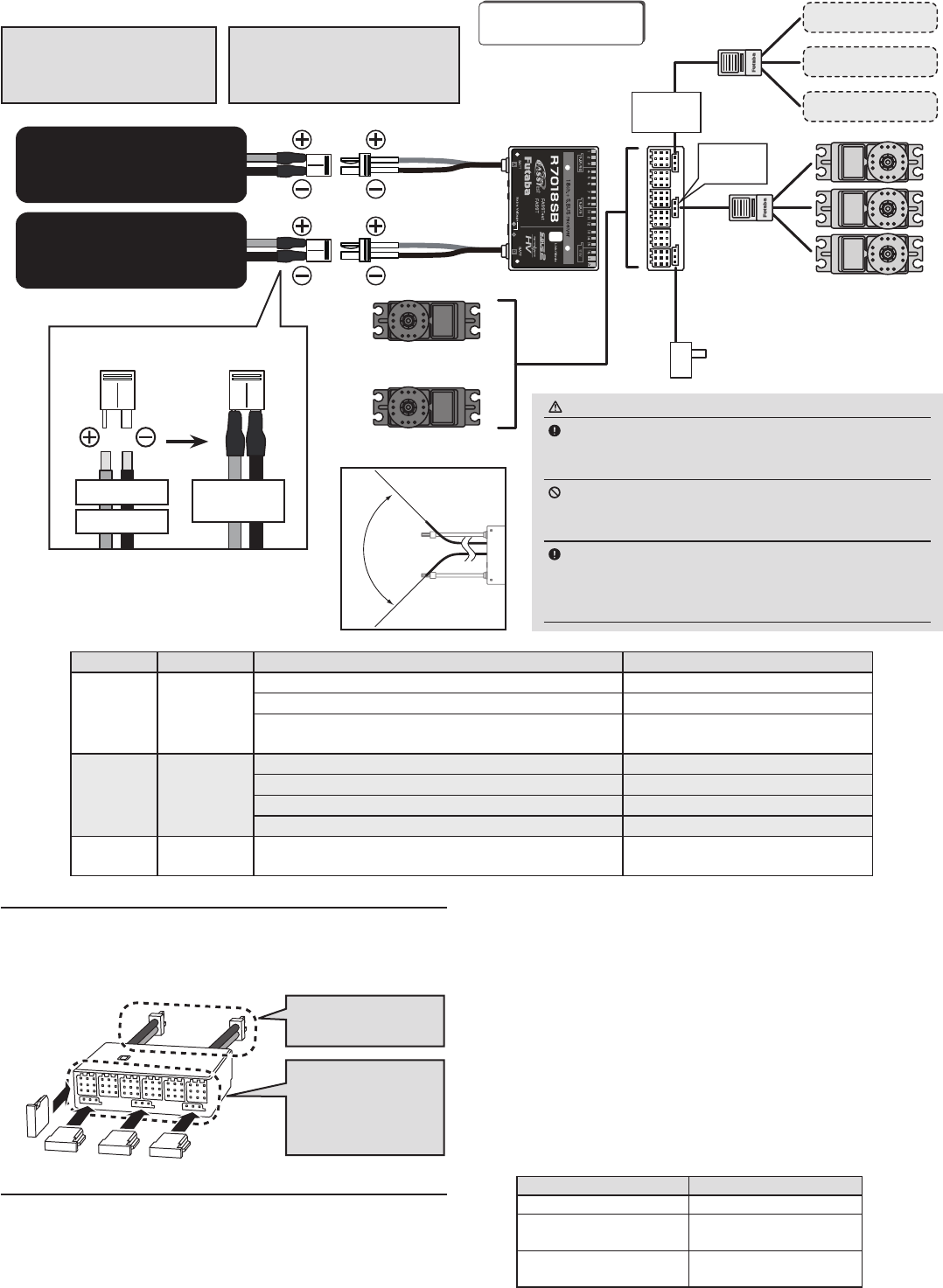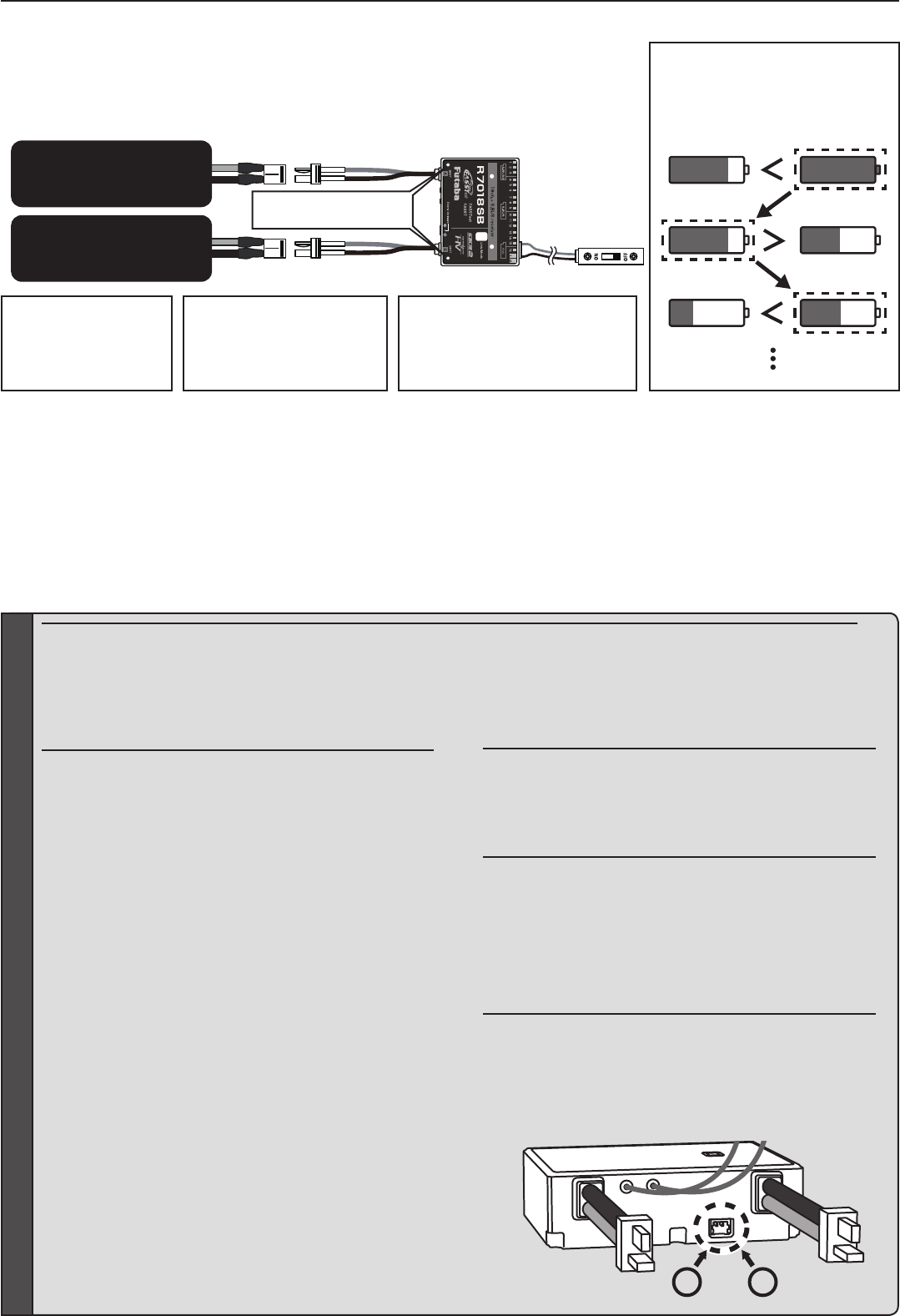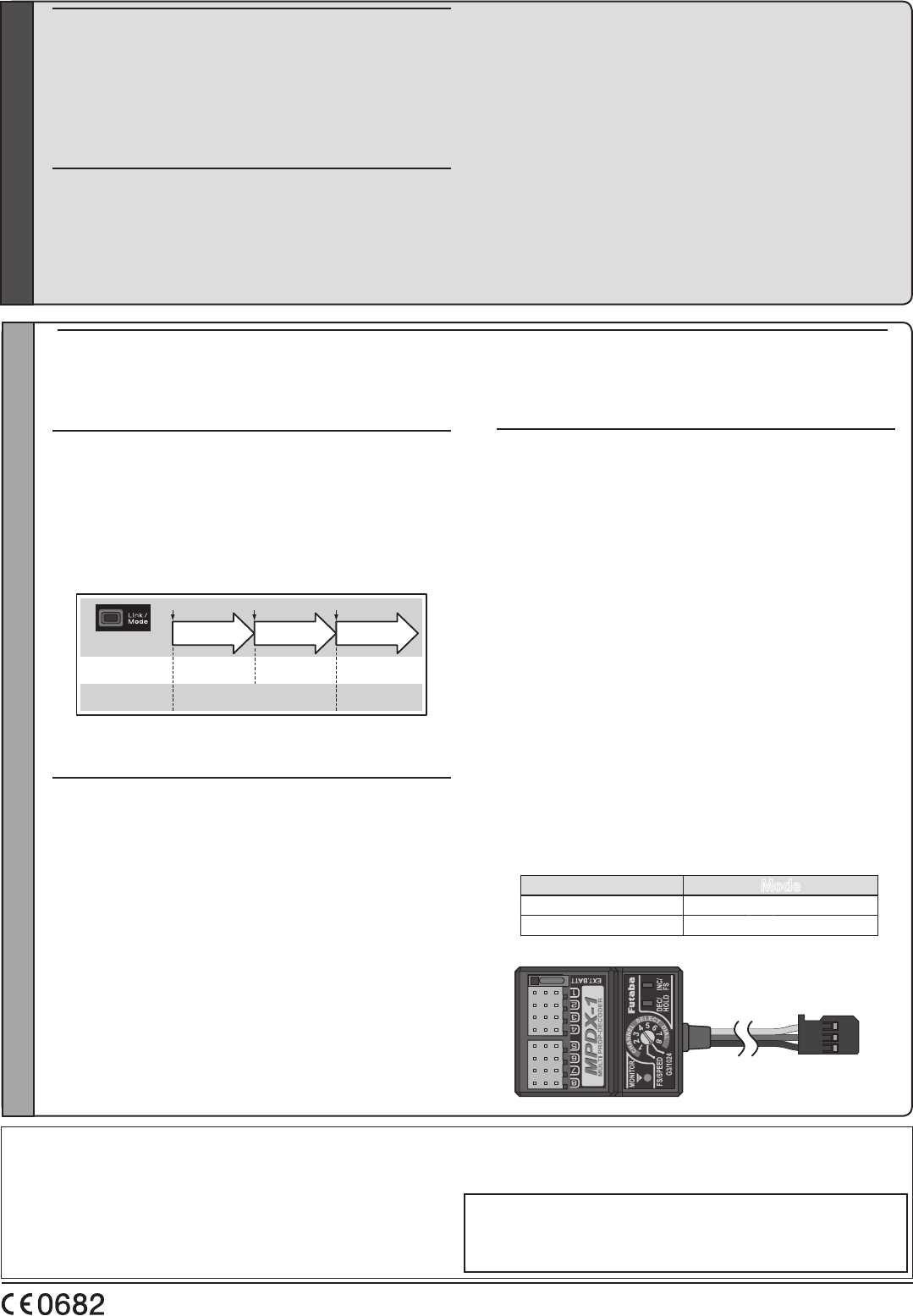User Manual

R7018SB
●Applicable systems: Futaba FASSTest-2.4GHz / FASST-Multi-ch system transmitter
The R7018SB has a Dual Battery System. Multiple servos can be driven by connecting 2 large capacity batteries. Even if the voltage
of one battery drops, the other battery allows safe ight. The R7018SB can also be switched the FASST-Multi-ch System.
◆FASSTest-2.4GHz Bidirectional Communication System / FASST-Multi-ch 2.4GHz
◆Dual Battery ◆S.BUS2 / S.BUS Port and 18 Channels for Conventional System Receiver
1M23N30102
CONTENTS
ESC ( motor controller) that supplies power
from the drive battery (BEC- Battery Eliminator
Circuit) to the receiver cannot be used.
Ordinary switches
(SSW-J, HSW-J, HSW-L,
etc.) cannot be used.
Usage precaution
• Analog servos cannot be used with the R7018SB in the
FASSTest 12CH mode.
• When the FASST Multi-ch High-speed Mode is used, analog
servos cannot be used at the CH1 〜6 outputs for convention
systems. However, in other than the FASSTest 12CH mode,
analog servos can be used at CH7 〜16, DG1 and DG2 at
any time.
• Don't connect to Extra Voltage Telemetry Port before turning
on a receiver.
WARNING
Changes or modication not especially approved by the party
responsible for compliance could void the user’ s authority to
operate the equipment.
When the model is not being used, always remove or
disconnect the battery.
■When the switch is off, a slight amount of current still flows. Unless the
switch and battery are disconnected, the battery will be damaged from
excessive discharge.
The R7018SB receiver should be protected from vibration by
foam rubber, Velcro, or similar mounting methods. Protect from
moisture.
Keep away from conductive materials to avoid short circuits.
When only one battery is connected, always insulate the
unused connector.
Antenna installation precaution
Do not cut or bundle the receiver antenna wire.
Do not bend the coaxial cable. It causes damage.
The antennas must be mounted in such a way to assure they
are strain relieved.
Keep the antenna as far away from the motor, ESC and other
noise sources as you possibly can.
Be sure that the two antennas are placed at 90 degrees to each
other.
■The R7018SB has two antennas. In order to maximize signal
reception and promote safe modeling Futaba has adopted a diversity
antenna system. This allows the receiver to obtain RF signals on both
antennas and fly problem-free.
Antenna installation for carbon fuselage
You must leave 30mm at the tip of the antenna fully exposed.
The exposed antenna should be secured so that it cannot move
around or back inside of your aircraft.
Be careful of connector insertion
Don't connect an S.BUS servo / gyro to S.BUS2 connector.
Do not connect the power supply battery to other than the
power supply connector.
■There is the danger of ignition, explosion, or burning.
Link precaution
Do not perform the linking procedure while the motor's main
power connected or the engine is operating as it may result in
serious injury.
When the linking is complete, please cycle the receiver power
and ensure the receiver is properly linked to the transmitter.
Please power up your system in this order. Transmitter rst,
followed by the receiver.
If the R7018SB receiver was previously linked to another
transmitter, make sure that transmitter is not operating while
linking the receiver to the new transmitter.
R7018SB × 1
Exclusive switch × 1 Mini driver × 1
Female Deans
Ultra Plug ×2
Heatshrink tube
Link/Mode
switch
Battery connector
Deans Ultra Plug
Antenna
Mode LED
Link LED
Battery(B)LED
Battery(A)LED
Use a Deans Ultra Plug with
the R7018SB power supply
battery. Batteries of this
connector cannot be used.
Extra Voltage
Telemetry Port
Thank you for purchasing a Futaba R7018SB FASSTest-2.4GHz compatible receiver. The R7018SB receiver features bi-directional
communication with a FASSTest Futaba transmitter using the S.BUS2 port. Using the S.BUS2 port an impressive array of telemetry
sensors may be utilized. It also includes both standard PWM output ports and S.BUS output ports.
Compliance Information Statement
(for U.S.A.)
This device, trade name Futaba Corporation, model number R7018SB,
complies with part15 of the FCC Rules. Operation is subject to the following
two conditions:
(1) This device may not cause harmful interference, and
(2) This device must accept any interference received, including interference
that may cause undesired operation.
(3) This module meets the requirements for a mobile device that may be used
at separation distances of more than 20cm from human body.
To meet the RF exposure requirements of the FCC this device shall not be co-
located with another transmitting device.
The responsible party of this device compliance is:
Futaba Service Center
3002 N Apollo Drive Suite 1, Champaign, IL 61822 U.S.A.
TEL (217)398-8970 or E-mail: support@futaba-rc.com (Support)
- 1 -

90˚
(Antenna installation)
Connector
The direction of the connectors of the bottom 3 ports is
different by 90˚.
R7018SB
1-18CH Servos
S.BUS servos
S.BUS Gyros
Receiver(Servo)Battery A
(e.g., Li-po 2 cell 7.4V)
Receiver(Servo)Battery B
(e.g., Li-po 2 cell 7.4V)
Hub
Hub
Exclusive switch
S.BUS2equipment
Telemetry sensor
Telemetry sensor
S.BUS2
Port
S.BUS
Port
D
G
D
G
Do not connect
a battery to
the ports at
this side.
Battery
connector
Do not use a battery of the
wrong rated voltage and
type (Li-po, Li-Fe, etc.).
When the receiver is not in
use, always disconnect the
battery.
WARNING
Never reverse the battery polarity.
■A reverse connection the battery terminals may cause
abnormal heating, fire and burns.
Do not short circuit the battery terminals.
■A short circuit across the battery terminals may cause
abnormal heating, fire and burns.
Be careful when soldering to the plug; don't overheat
the plug with your soldering iron and take great care to
avoid short-circuits on the plug.
■Such a overheat and short-circuit would destroy the plug.
LED Indication
System Mode LED Status Link LED
FASSTest Green Solid
No signal reception Red Solid
Receiving signals Green Solid
Waiting for link Start → 2second later → Red
Blink(1second)
FASST O
No signal reception Red Solid
Receiving signals Green Solid
Receiving signals but ID is unmatched Green Blink
Waiting for link Red Blink
FASSTest
FASST -Unrecoverable error (EEPROM, etc.) Alternate blink
*Fixed at neutral if a servo is connected to a port other than a usable
transmitter channel.
*The telemetry and Extra Voltage ports cannot be used with the
FASST system.
FASSTest ⇔ FASST (Normal-High-speed)
Change method
1. Turn on the receiver.(Transmitter OFF)
2. Press and hold the Link/Mode button for more then 5 second.
3. When the LED begins to blink green/red the button may be
released.
4. The LED should now be blinking red in one of the patterns
described by the chart below.
( Default : FASSTest )
5. Each press of the Mode/Link button advances the receiver to
the next mode.
6. When you reach the mode that you wish to operate in, press
and hold the Mode/Link button for more than 2 seconds.
7. Once locked into the correct mode the LED will change to a
solid color.
8. Please cycle the receiver(s) power off and back on again
after changing the Channel Mode.
Red LED blink System
1 time FASSTest
2 time FASST Multi-ch
Normal mode
3 time FASST Multi-ch
High-speed mode
Connection
Female Deans Ultra Plug
Soldering
Battery Wire
Heatshrink
tube
- 2 -

Dual Battery System
Two power supply batteries can be connected to the R7018SB. Power is supplied from
the battery with the highest voltage. The operating time is the total time of the 2 batteries.
For example, even if the voltage of one battery drops, power can be supplied from the
other battery. Even one battery can be used, but safer ight is possible if 2 batteries are
used.
This receiver employs an electronic switching (current is controlled by an FET circuit) system. When the exclusive switch is
set to ON or is pulled, the power is turned on. Switches other than the exclusive switch cannot be used. In addition, since a
very small current ows even when the power is off, always disconnect the battery from the connector when the receiver is not
in use.
One or 2 batteries can be connected. When 2 batteries are connected, the battery with the highest voltage is used. When only
one battery is connected, always insulate the unused connector. The battery can be connected to either side.
In addition, since this receiver does not have a built-in voltage regulator, use batteries with sufficient capacity for the
specications and number of servo motors to be used.
R7018SB
Exclusive switch
Receiver(Servo)Battery A
(e.g., Li-po 2 cell 7.4V)
Receiver(Servo)Battery B
(e.g., Li-po 2 cell 7.4V)
D
G
D
G
Even if the voltage of
one of the batteries
drops, power is supplied
from the other battery.
Even if the power supply
wiring of one of the batteries
breaks, power is supplied
from the other battery.
When the switch is set to ON,
power is supplied from the battery
with the highest voltage. The
operating time is the total time of
the 2 batteries.
Electric power will be automatically
and alternatively supplied from the
battery which voltage is higher.
LED of the battery being
used lights.
FASSTest
FASSTest
FASSTest is a bidirectional communication system between the R7018SB receiver and FASSTest capable transmitters.
Multiple optional telemetry sensors may be connected to the S.BUS2 on the receiver and that data is in turn displayed on
the transmitter.
*Please see your transmitters operation manual to configure transmitter to operate with telemetry sensors.
Link to the transmitter : FASSTest
1 Bring the transmitter and the receiver close to each
other, within 20 inches (half meter).
2 Turn on the transmitter. Place the transmitter into the
receiver linking mode.
3 Turn on the receiver.
4 The receiver will wait for the linking process to begin
for 2 seconds. Following that it will return to the normal
operation mode.
5 When the LED of the receiver changes from blinking red
to solid green, linking is complete.
(A link waiting state is ended in 1 second.)
• Refer to the transmitters operation manual for complete
details on how to place the transmitter into the linking
mode.
• If there are many FASSTest systems turned on in close
proximity, your receiver might have difficulty establishing
a link to your transmitter. This is a rare occurrence.
However, should another FASSTest transmitter/receiver
be linking at the same time, your receiver could link to
the wrong transmitter. This is very dangerous if you do
not notice this situation. In order to avoid the problem,we
strongly recommend you to double check whether your
receiver is really under control by your transmitter.
• If the System Type of the transmitter is changed, the
receiver will need to be re-linked to the transmitter.
S.BUS2
S.BUS2 extends S.BUS and supports bidirectional
communication. Sensors are connected to the S.BUS2
port.
*Only S.Bus2 capable devices may be connected to the S.Bus2
port. Standard S.Bus servos and gyros should not be connected
to the S.Bus2 port.
Receiver voltage transmitter display
The voltage displayed at the transmitter is only that of the
battery currently in use (battery with the highest voltage).
*The voltage of the 2 batteries cannot be displayed individually.
Extra Voltage Telem etry port
It connects with the battery for power, etc.
External voltage input cable (CA-RVIN-700) of an option
is used. The voltage of the battery can be displayed with a
transmitter.
+
-
- 3 -
Battery A Battery B
Supplied from
battery A
Supplied from
battery B
Supplied from
battery B

Link to the transmitter : FASST
1 Bring the transmitter and the receiver close to each
other, within 20 inches (half meter).
2 Turn on the transmitter and receiver.
3 Link operation is performed by the Link/Mode switch.
• When using TM-8 module, it's possible to set F/S position (only 3CH).
0 to 1 sec. 1 to 2 sec. More than 2 sec.
0 sec. 1 sec. 2 sec.
Press and Hold time
No function
With TM-8
(not included in this set)
To set the F/S
position(No re-link)
Re-link(ID set) and to
set the F/S position
No function
Besides TM-8 Re-link(ID set)
*Refer to the instruction manual of the transmitter or module used
for a description of the linking operation, F/S position setting
methods and other details.
When using Multi prop (MPDX-1)
The MPDX-1 can be used with FASSTest by merely
setting the corresponding transmitter. (Refer to the
instruction manual of the corresponding transmitter.)
When using the MPDX-1 Multi Prop Decoder (sold
separately) with the FASST system, change the setting by
the following method.
Enable the MPDX-1 at channels 11 and 12. (Initial value:
OFF)
Channels 11 and 12 cannot be used individually for
MPDX-1 output.
The MPDX-1 extends 1 channel to 8 channels. However,
since the response speed becomes slower and there are
functional restrictions, use it at simple switch operation
and other applications that require numerous channels.
Multi prop mode Change method
1. Switch the receiver to the FASST system (Normal or
High-speed).
2. Turn on the receiver power. (Transmitter power off)
3. Press the Link/Mode switch for at least 10 seconds.
4. When the LED blinks red and changes to red/green
simultaneous rapid blinking, release the switch.
5. The receiver enters the multi prop mode and the LED of
the current mode blinks. (Initial value: OFF)
6. Each time the switch is pressed, the mode changes.
7. When the receiver was switched to the desired mode,
press the Link/Mode switch for at least 2 seconds.
8. When the LED switches to red/green simultaneous
rapid blinking, mode switching is complete. Release the
switch.
9. When switching is complete, turn on the power. When
the power is turned on, the receiver switches to the new
mode.
FASST
When switched, the R7018SB can use the FASST-Multi-ch mode. When the FASST system is used, the telemetry and
Extra Voltage ports cannot be used. The FASST system has a Normal mode and a High-speed mode. However, in the
High-speed mode, analog servos cannot be used at CH1 〜6.
Green LED blink Mode
1 time Multi prop mode OFF
2 time Multi prop mode ON
FASSTest FASST
When a telemetry adapter (TMA-1) is used
: FASSTest only
When using a TMA-1 (sold separately), change the
settings by the following method.
The TMA-1 is a device for viewing the telemetry data on
a smartphone or tablet.
R7 0 18S B a nd T M A-1 l i nki n g me t h od
1. Switch the receiver to FASSTest system.
2. Link the transmitter and receiver, and after confirming
operation, turn off the power.
3. Turn on the receiver power. (Transmitter power off)
4. Press the Link/Mode switch for at least 10 seconds.
5. After the LED blinks red and changes to red/green
simultaneous rapid blinking, release the switch.
6. The receiver enters the linked with TMA-1 mode, and
the LED begins red/green simultaneous rapid blinking.
7. Press the TMA-1 link switch until the LED starts to blink
and wait for the TMA-1 to link.
8. When TMA-1 linking is complete, the TMA-1 LED
changes from red to green for a moment.
9. When linking is complete, turn on the receiver power
and check the operation of all the devices.
MPDX-1(Option)
FUTABA CORPORATION
1080 Yabutsuka, Chosei-mura, Chosei-gun, Chiba-ken, 299-4395, Japan
Phone: +81 475 32 6982, Facsimile: +81 475 32 6983
©FUTABA CORPORATION 2015, 4 (1)
R7018SB Specications
FASSTest-2.4GHz system(18CH/12CH mode)FASST-2.4GHz system
(Multi-ch mode)
S.BUS2 and S.BUS port and Linear 16 ch +Digital 2 ch for conventional
system receiver
• Dual antenna diversity
• Size: 2.15 x 1.59 x 0.64 in. (54.6x40.4x16.3mm)
• Weight: 1.48 oz. (42g)
• Power requirement: 6.0V to 7.4V(Voltage range: 4.8 to 8.4V)
• Battery F/S Voltage: It sets up with a transmitter (F/S can't be used in
case of FASST.)
• Extra Voltage port: 0 ~70V DC
- 4 -
All product and company names mentioned
herein are the trademarks or registered
trademarks of their respective owners.
本產品符合低功率電波輻射性電機管理辦法 第十二條、第十四條等條文規定
1. 經型式認證合格之低功率射頻電機,非經許可,公司、商號或使用者均不得擅自變更頻率、加
大功率或變更原設計之特性及功能。
2. 低功率射頻電機之使用不得影響飛航安全及干擾合法通信;經發現有干擾現象時,應立即停用,
並改善至無干擾時方得繼續使用。前項合法通信,指依電信法規定作業之無線電通信。低功率
射頻電機須忍受合法通信或工業、科學及醫療用電波輻射性電機設備之干擾。